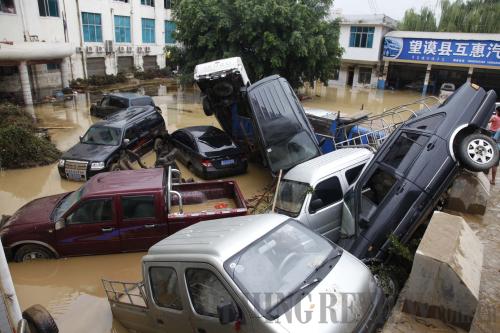|
 |
|
UPSIDE DOWN: Motor vehicles lie scattered about in flood-hit Wangmo County in Guizhou Province (XINHUA) |
A Xinhua News Agency report said the drought has seriously affected farming along the Yangtze River, with Yunnan Province's farming industry suffering the most. About 86 percent of its farmland was hit by the drought, with the harvests of 3.07 billion hectares to be wiped out. Output of spring grains in the province is expected to decrease 50 percent, while that of sugar cane will decrease 20 percent. In addition, 2.55 million hectares of forests and orchards were affected, causing a loss of 600,000 kg of fruit production, a direct economic loss of 5.04 billion yuan ($775.4 million).
Prices of some agricultural products have soared because of the drought. As Yunnan is a major sugar cane-producing area in China, the drought has driven up sugar cane prices for four consecutive months, which, in turn, has forced manufacturers in the food industry to raise the prices for their products.
Some places in the five drought-affected provinces on the middle and lower reaches of the Yangze River have yet to be lifted from the aftermath. Prices of rice, vegetables and freshwater products from these regions have all increased, which has weighed on inflationary concerns in the domestic market.
Compared with the drought, the floods hit a larger area and population. By June 7, the floods had affected 438,200 people in Guizhou, with more than 98,300 having been relocated and more than 50 reported dead or missing. About 19,849 hectares of farmland experienced some degree of flooding, with 9,687 hectares completely destroyed. The floods also damaged 5,956 houses and collapsed 2,804 homes.
The National Disaster Reduction Committee and the Ministry of Civil Affairs updated the level-4 national disaster emergency response plan to level 5 on June 7. Jiang Li, Vice Minister of Civil Affairs, led a collaborative work team with members from eight ministries to the disaster-hit areas to comfort residents and assist with the disaster relief work.
Damage control
A sharp turn in weather, from drought to instant flooding, tends to take a heavy death toll since people are unprepared, said the SFDH Office. Heavy downpours have the potential to flood low-lying farms and villages or cause landslides in mountainous regions. Dams also come under pressure if they are not able to discharge the excess water fast enough.
The sharp turn of disasters happened along the Huaihe River to the north of Yangtze River in 2005 and along the Pearl River to the south of Yangtze River in 2010 all caused deaths and heavy property losses. The major reasons for the sharp turn this time were waterlogging in irrigation canals, lakes and ponds and a sudden change of weather.
The SFDH Office called for timely and accurate warnings and effective prevention efforts against such natural disasters. For instance, reservoirs should be drained for sudden increases in water levels; and disaster-relief personnel and materials should always be readily available to ensure a quick response when an emergency occurs.
The office also requires efforts to maintain the water diversion quantity from rivers to irrigation canals and ditches at a reasonable level to ensure these facilities work properly. Disaster-relief schemes should be put in place in advance to answer any emergency call. Local governments should work out feasible emergency schemes to address any rainstorm or mountainous torrents in accordance with local conditions and conduct rehearsals of such schemes for the sake of avoiding deaths and losses in such emergency cases.
Flood Statistics
By June 11, the sudden rainstorms in south China had triggered flooding in 13 provinces, damaging 310,000 hectares of farmland, affecting 8.48 million people (including 94 deaths and 78 missed), destroying 27,100 houses, and causing direct economic losses of 7.45 billion yuan ($1.15 billion).
(Source: State Flood Control and Drought Relief Headquarters) | 